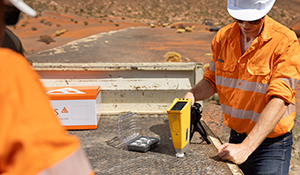The 5 Best Ways to Prepare Samples for XRF Analysis
Written By: AnalytiChem |

Sample Preparation for XRF Analysis
X-ray Fluorescence Spectrometry (XRF) is a powerful, comparative, chemical analysis technique capable of examining a wide range of materials in various forms, covering much of the periodic table. Its versatility makes it useful in numerous applications—from quality control of metal alloys, to analyzing sulfur in gasoline, to detecting heavy metals in plastics and electronics.
While XRF can analyze almost any material that can be presented to the spectrometer, the accuracy of your analytical results is highly dependent on sample preparation. Choosing the right preparation method is a balancing act between the quality of results required, the effort involved (labor, complexity), and associated costs (equipment, labor, and turnaround time). Your optimal choice may differ depending on the material type and your specific analytical needs.
How Do You Choose the Right Sample Preparation Method?
Let’s walk through the five most common sample preparation techniques for XRF analysis—and what you need to consider with each.

Solid Samples
Solid samples can range from unprepared chunks of metal, electronics, or plastics to precision-cut and polished specimens. Ideally, the sample should have a perfectly flat surface. Irregular surfaces change the distance between the sample and the X-ray source, which introduces analytical error. XRF instruments are calibrated based on a fixed distance between the sample and the source, so any variation affects elemental intensity readings.
In many cases, solid metal alloys can be analyzed as-is. However, for more quantitative results—especially in alloy control applications—samples are often cut and polished. Even relatively flat surfaces can affect measurements, particularly for lighter elements. Rough finishes scatter and reabsorb X-rays from low-energy elements like carbon and sulfur, while higher-energy signals like nickel may remain unaffected. For accurate quantitative analysis, a fine surface finish—achieved using a lathe or grinding paper—is critical.
One important note: whatever sample preparation method you apply to your unknown samples should also be applied to your calibration standards for consistent, reliable results.
Loose Powders
Loose powders are typically analyzed by placing the sample into a plastic cup with a thin support film. This ensures a flat surface and keeps the sample suspended over the X-ray beam. Finer grinding improves sample homogeneity and reduces voids, both of which improve analytical precision. Using about 15 grams of sample is generally sufficient to achieve "infinite thickness" for most elements, ensuring accurate intensity readings.
For metal powders analyzed in high-power (2–4 kW) WDXRF systems, be cautious: excessive heat buildup can melt the support film, potentially spilling abrasive material into your instrument—an expensive mistake to avoid.
Pressed Pellets
Pressed pellets offer more rigorous sample prep than loose powders. The process involves grinding the sample to a fine powder—ideally below 75 µm—mixing it with a binder (usually a cellulose-wax blend) and compressing the mixture at 20–30 tons of pressure to form a uniform pellet. A common ratio is 20–30% binder to 70–80% sample.
This method yields better analytical results than loose powders due to its improved homogeneity and reduced void spaces. Although it still suffers from particle size effects if grinding is insufficient, pressed pellets generally provide stronger and more reliable signals. They're particularly effective for detecting elements at parts-per-million (ppm) levels and require only basic equipment such as a pulverizer and a sample press.
Fused Beads
Fused beads are often considered to be the “gold standard” in XRF sample prep for solid samples. This method produces an exceptionally homogeneous sample by mixing a finely ground powder (<75 µm) with a flux (typically lithium tetraborate or a tetraborate/metaborate mix) in a ratio of 5:1 to 10:1, then melting the mixture at 900–1000°C in a platinum crucible. The molten mix is poured into a mold to form a flat-bottomed glass disc.
The result: a sample free of mineral structure, minimizing matrix effects and enhancing analytical accuracy. This means that fused beads also allow for multiple matrix types to be calibrated on the same curve. However, drawbacks include higher sample dilution—which can limit trace element detection—and significant upfront costs (fusion equipment, platinum ware). Also, with a typical thickness of ~3 mm, infinite thickness concerns may arise for heavier elements.
Liquids
 Liquids are typically analyzed using the same method as loose powders—poured into a plastic cup and sealed with a support film. The key challenge lies in choosing the right film that balances strength, chemical compatibility, and X-ray transmission.
Liquids are typically analyzed using the same method as loose powders—poured into a plastic cup and sealed with a support film. The key challenge lies in choosing the right film that balances strength, chemical compatibility, and X-ray transmission.
- Mylar is a common, general-purpose film suitable for analyzing sulfur in fuels or lubricants.
- Polypropylene offers better transmission but has lower tensile strength.
- Kapton is highly durable and resistant to many chemicals but attenuates light elements and is vulnerable to strongly basic solutions.
When analyzing liquids, selecting the right film is crucial to achieving both safety and sensitivity. The best practice is always to test your sample and film combination outside of the XRF to avoid costly, hard to clean spills and downtime.
Conclusion
Sample preparation is one of the most important factors in successful XRF analysis. Your method should reflect a balance between sample type, desired accuracy, effort, and cost. By understanding the strengths and limitations of each technique, you can tailor your preparation strategy to get the most out of your XRF system.



